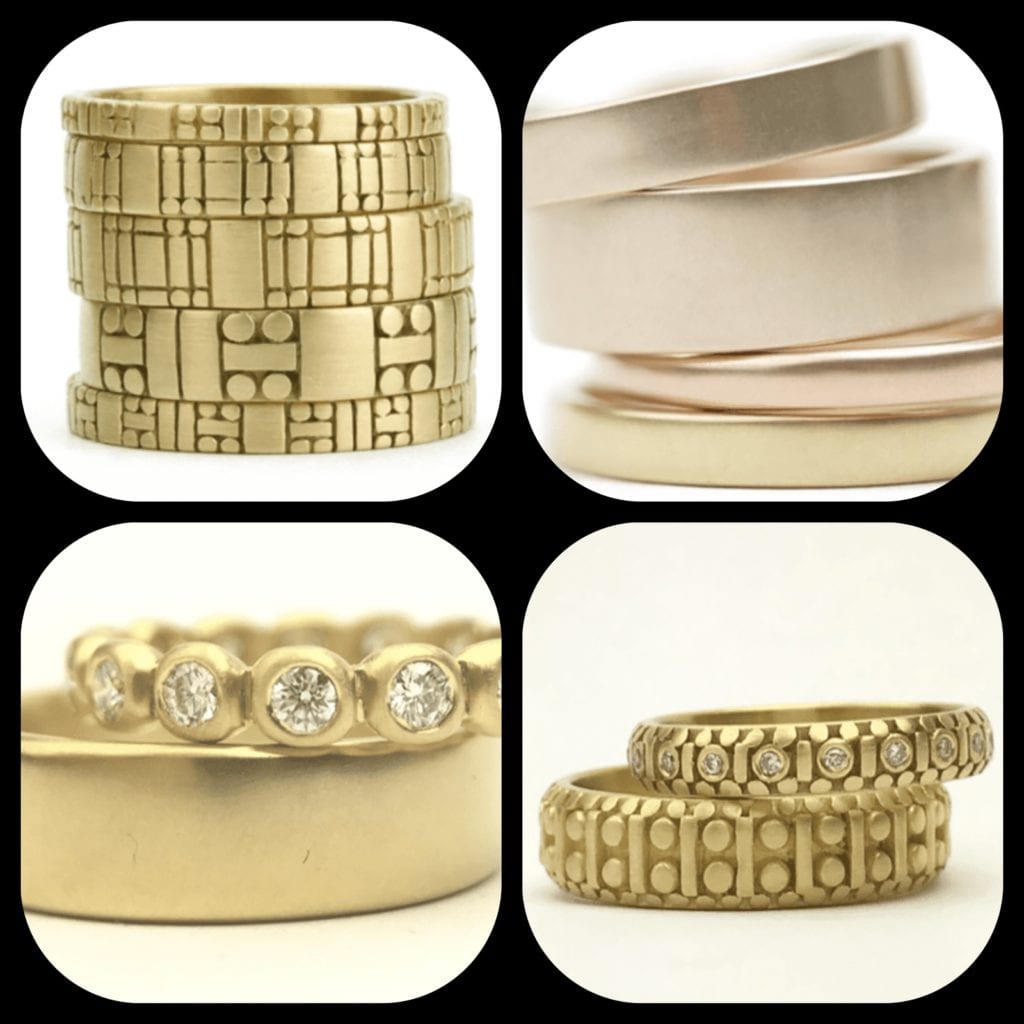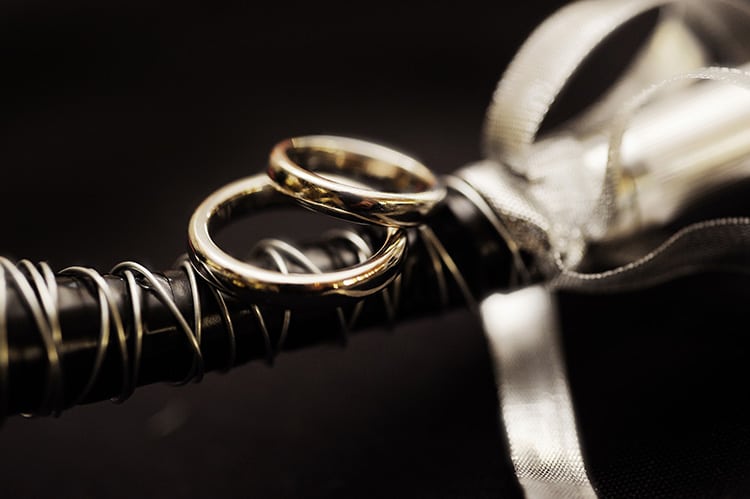
Platinum and gold are the two most popular men’s wedding band materials; they are both precious metals and they share some properties. But it’s the differences between the two that will make or break your choice when looking for a wedding band. Along with their traditional appeal, both of these metals hold their value well over time, are soft enough to be easily removed in an emergency, and tend to be alloyed (mixed with other materials) when used in jewelry. Before we dive in, note: These are both fine choices. There is no wrong answer.
Some of the key differences; platinum is harder to resize than gold but tends to be more durable. There’s also a cost difference; platinum costs almost twice as much per ounce as gold. Below is our detailed guide to picking between a platinum and gold wedding band. And when discussing which metal is the better value and the least allergenic, we name winners and losers.
What’s the Difference Between Gold and Platinum?
Platinum is more expensive than gold but it is not necessarily better. Both materials are considered “precious” metals and have been standards in jewelry for over a century. In the early part of the last century, platinum was the preferred metal for wedding bands, but the US government controlled its use during the Second World War because it had military value. Today, platinum is seen less often than gold, but is an increasingly popular choice.
Gold and Platinum Properties & Weight
Both gold and platinum are generally sold as alloys rather than as pure metals. Platinum tends to be either 900 Plat or 950 Plat — 90 percent and 95 percent platinum, respectively. These alloys are easier to work with and much harder than pure platinum, making them better suited for day-to-day wear. Platinum is very dense and extremely resistant to corrosion. This is why it was chosen for the international prototype kilogram as it will never change in mass through corrosion and a very small amount — just larger than a golf ball — weighs 2.2 pounds or exactly 1kg. This also means that a platinum ring will feel much heavier than a gold band of the same width.
Gold comes in several alloys, and although 24 karat gold is the purest, it isn’t really that useful for jewelry as it is soft and damages easily. Each karat is 1/24th of the whole, so a 12 karat ring is 50 percent gold with the rest generally being copper or silver. Most gold rings are 18 or 14 karat gold and tend to be slightly less dense than platinum rings of the same size. Stick with 14k gold for rings; it costs less and is more scratch-resistant.
Gold and Platinum Colors
Of course, both metals look different as well. Gold naturally has a yellow hue, whereas platinum tends to be silver and shiny. White gold is not naturally that color; instead, it is alloyed with something like silver or nickel and often coated in rhodium for a shinier finish (photo below, left). This finish needs replenishing every few years, but it is easy to do and often free at a good jeweler.
Platinum (photo below at right) is naturally a shiny grey color, and shouldn’t require much upkeep at all. If you’re already tossing up between the two metals, the easiest way to pick one is on color grounds. White gold will eventually yellow unless you get it refinished, while platinum and yellow gold will always stay the same color. If you want a gray/silver ring, buy platinum. If you want a yellow ring, buy gold.

White Gold 
Platinum
Then, of course, there are also rose gold rings, like the one below from Brilliance.

Gold and Platinum Durability
Platinum alloys are generally denser than gold alloys and thus tend to be more durable. However once gold gets to 14K, it tends to be harder than platinum and less easy to scratch. This means that platinum is preferred for intricate rings, like engagement rings that hold a stone, as its strength keeps the stone safe. However, gold is a better choice if you are worried about scratching your ring.
But it’s not quite that simple. When gold is scratched it tends to be lost, whereas platinum tends to move to another place on the ring. This means a platinum ring will develop a weathered patina, which many people find desirable, whereas gold might need refinishing after a scratch.
Both metals are excellent choices for engraving so that should not impact your wedding band choice. Here’s an example of an engraved platinum band (left) and a durable 14K gold ring, both from James Allen.

Platinum 
Gold
Winner: Tie. Platinum is usually more durable than gold, but 14k gold has alloys that may make the gold more scratch-resistant.
Gold and Platinum Prices
There’s no getting around the fact that platinum costs a lot more than gold. With only 160 tons of platinum mined every year, there just is not much to go around. 1,500 tons of gold are mined every year, and basic supply and demand suggest that it should be cheaper. But there’s a twist.
The raw material cost of platinum is $970 per ounce compared to $1,590 for gold (prices will fluctuate with the market). But remember those alloys we discussed earlier? You’ll recall that gold is generally much less pure than platinum by the time it makes it into a ring. Platinum is also denser, meaning that one ounce of platinum is much smaller than the same weight of gold. Platinum is also a more challenging metal to work with, which also requires expert labor. This means that regardless of the raw material price, a gold ring is likely to cost less in its finished form.
You may also wish to consider that there is much more labor involved in resizing a platinum ring, meaning you might spend more down the line if you wish to resize once you outgrow your wedding band. Resizing a platinum band costs between $100 and $300, while for a gold band you will be looking at $20 to $50.
Because Platinum is expensive, wider rings go up in price a lot more than 14k gold. This example below comes from Brilliant Earth.

What does this mean in terms of ring costs? A 6mm classic wedding band from Blue Nile made of Platinum (below, left) will set you back $742.50 and if you opt for the same ring in 14 karat gold (below, right), you will be paying $441. (Below left: Platinum. Below right: 14K yellow gold. Photos courtesy of Blue Nile)

Platinum 
Gold
A milgrain band ring, which is a popular choice for a more modern look, will set you back $1,510 for a platinum band (below, left). The same effect for a yellow gold band (below, right) will cost you $1,000. (Below left: Platinum. Below right: 14K yellow gold. Photos courtesy of James Allen)

Platinum 
Gold
Neither of these metals is cheap, but there is still a significantly higher price for a platinum band. Both gold and platinum are great investments and should hold their value for years. Gold, which is easier to work with, can also be re-formed into other jewelry. My wife’s ring, for instance, is made from her grandmother’s old wedding band.
Winner: Gold is usually less expensive than platinum, all things being equal.
Which is better for people with allergies: gold or platinum?
Have you noticed a rash, bumps, or irritation from your band or other jewelry? Chances are that you are allergic to one of the metals in the ring. It is likely not the precious metal, but one of the alloys. Usually, the culprit is nickel, which is used in gold alloys but not in platinum alloys. Therefore, if you’re allergic to something in jewelry, or think you might be, go with a platinum band.
Loser: Gold is more likely to cause irritation.
Gold vs Platinum: Bottom Line
If you’re looking for a ring that will develop a nice patina, continue to keep its color, and feels dense, pick platinum. If you are on a budget or prefer a ring that allows for easier resizing, pick gold. Ultimately, the major deciding factor is going to be color. Platinum’s naturally shiny grey hue will either appeal to you or not; the alternative is the warm yellow of gold.















